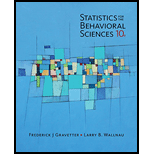
Concept explainers
- In problem 13 in Chapter 17, we Discussed a study by Loftus and Palmer (1974) examining how different phrasing of questions can influence eyewitness testimony. In the study, students watched a video of an automobile accident and then were questioned about what they had seen. One group of participants was asked to estimate the speed of the cars when ''they smashed into each other.” Another group of was asked to estimate the speed of the cars when "the y hit each other.'' Suppose that the actual speed of the cars was 22 miles per hour.
- For the 50 people in the “smashed-into'' group, assume that 32 overestimated the actual speed
17 underestimated the speed, I was exactly right. ls this result significantly different from what would be expected by chance? Use a two tailed
test with a = .05.
In a classic study, Loftus and Palmer (1974) investigated the relationship between memory for eyewitnesses and the question they are asked.
In the study participants watched a film of an automobile accident and then were questioned about the accident. One group was asked how fast the cars were going when they “smashed into” each other.
A second group was asked about the speed when the car. “Hit” each other, and a third group was not asked any question about the speed of the cars. A week later, the participants returned to answer additional questions about the accident, including whether they recalled. Seeing any broken glass. Although there was no broken glass in the film, several students claimed to remember seeing it. The following table shows the frequency distribution of response for each group.
Response to the Question
Did You See Any Broken Glass?
Verb Used to Ask About the Speed
Verb Used as Ask About t, he Speed
Smashed into Hit
Control (Not Asked)
Response about Broken Glass
Yes: No
- Does the proportion of participants who claim to remember broken glass differ significantly from group to group? Test with a = .05.
- Compute Cramer’s V to n1easnfle the size of the treatment effect.
Want to see the full answer?
Check out a sample textbook solution
Chapter 18 Solutions
Statistics for The Behavioral Sciences (MindTap Course List)
- Human Cannonball Referring to Problem 29, find the height reached by the human cannonball after he has traveled 40 feet horizontally, and after he has traveled 140 feet horizontally. Verify that your answers are correct using your graphing calculator.arrow_forwardHelp me solve questions 15-17 using the following dataarrow_forwardProblem 6: Boris and Bela Polling Company has polled 900 voters of Betropolos and 495 say that they will vote for Bill for Sheriff. Estimate the proportion, p, of votes that she will get from the population with a level of confidence of 95%. Your final answer should be correct to 3 places after the decimal point. _________ < p < ________arrow_forward
- Problem 10.5. Are sexually active teenagers any better informed about AIDS and other potential health problems related to sex than teenagers who are sexually inactive? A 15-item test of general knowledge about sex and health was administered to random samples of teens who are sexually inactive, teens who are sexually active but with only a single partner, and teens who are sexually active with more than one partner. Is there any significant difference on the test scores? Use the graph below to find the answer.arrow_forwardProblem No. 5. Suppose a 10-item test in Math (x) and a 10-item test in English (y) were administered to 10 students. The scores of Student 1 to 10 are shown in the parenthesis, with x:y scores listed per student. (Student 1-4:5; Student 2-5:4; Student 3-9:8; Student 4- 2:3; Student 5- 8:9; Student 6- 1:2; Student 7- 2:1; Student 8- 7:6; Student 9- 6:7; Student 10- 4:5). Determine the correlation coefficient. *arrow_forward
 Algebra: Structure And Method, Book 1AlgebraISBN:9780395977224Author:Richard G. Brown, Mary P. Dolciani, Robert H. Sorgenfrey, William L. ColePublisher:McDougal Littell
Algebra: Structure And Method, Book 1AlgebraISBN:9780395977224Author:Richard G. Brown, Mary P. Dolciani, Robert H. Sorgenfrey, William L. ColePublisher:McDougal Littell Trigonometry (MindTap Course List)TrigonometryISBN:9781305652224Author:Charles P. McKeague, Mark D. TurnerPublisher:Cengage Learning
Trigonometry (MindTap Course List)TrigonometryISBN:9781305652224Author:Charles P. McKeague, Mark D. TurnerPublisher:Cengage Learning Linear Algebra: A Modern IntroductionAlgebraISBN:9781285463247Author:David PoolePublisher:Cengage Learning
Linear Algebra: A Modern IntroductionAlgebraISBN:9781285463247Author:David PoolePublisher:Cengage Learning


